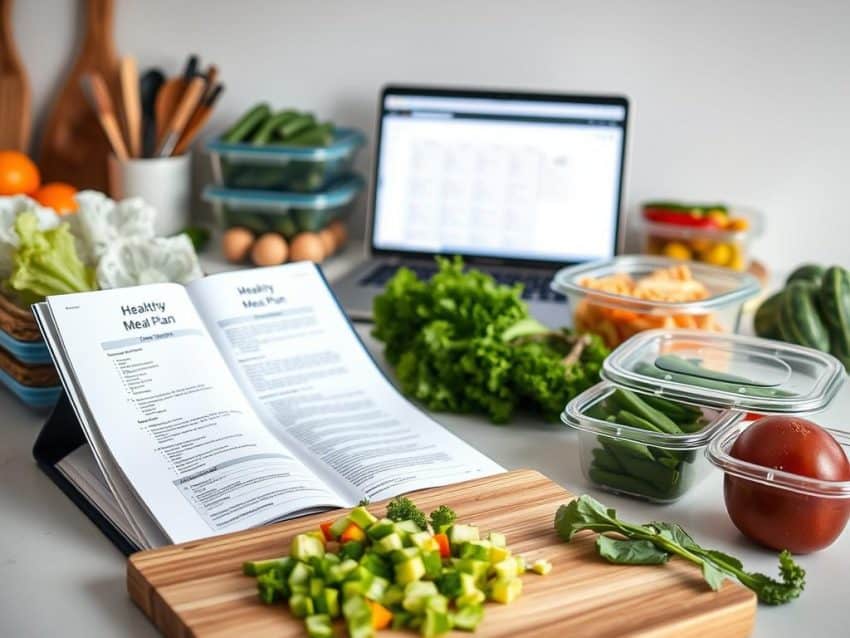Did you know that up to 40% of food in the United States goes uneaten each year? This is a big problem. Meal planning helps solve it by saving time, money, and promoting healthier eating. When I started planning my meals, it changed how I cooked and shopped for groceries.
I had more control over what I ate and got creative with leftovers. This reduced waste in my kitchen. Planning meals in advance also cut down on daily stress about what to cook. It helped me make healthier choices.
Apps like MeaLime and The Real Food Dietitians made planning easier. They helped me stay on track with my healthy eating goals. This guide will show you how meal planning can make your life simpler, just like it did for me.
Key Takeaways
- Meal planning reduces food waste by allowing you to repurpose leftovers.
- Apps can simplify the meal planning and grocery shopping process.
- Planning meals allows for better control over caloric intake and promotes healthier eating.
- Meal planning saves time by reducing daily decision fatigue.
- Cross-utilizing ingredients leads to greater efficiency and fewer impulse grocery purchases.
- Using the freezer for pre-cooked ingredients streamlines meal assembly during busy times.
Understanding the Basics of Meal Planning
Meal planning helps me organize my meals before they happen. It makes life easier and keeps me on track with healthy eating. By planning meals, I avoid daily stress and make choices that fit my diet.
What is Meal Planning?
Meal planning has three main steps: picking recipes, buying ingredients, and prepping meals. Talking with my family about meals helps meet everyone’s needs. I use a calendar or spreadsheet to keep track of meals and shopping lists.
Starting with just a few days’ worth of dinners is a good beginning. It lays the groundwork for my meal prep journey.
Benefits of Meal Planning for Healthy Eating
Meal planning offers many benefits beyond just dinner choices. It saves time and money, making grocery shopping easier and reducing waste. I label and date prepped items to track their freshness.
For example, cooked ground meat lasts 1-2 days, while whole meats stay fresh for 3-4 days. Hard-boiled eggs can last up to a week. Freezing meals extends their life even more.
Soups and stews can last 2-3 months, and cooked meats can be frozen for 3-6 months. Blanched veggies can keep for 6-8 months. This way, I make cooking simpler and enjoy my meal planning more.
How to Create an Effective Meal Plan
Starting a meal plan begins with setting aside time each week. I pick a day that fits my schedule, like Sunday. This day lets me plan meals based on my week’s activities.
Choosing Your Meal Planning Day
Choosing a meal planning day helps me see how busy I’ll be. I pick a day when I’m not too busy, like Sunday. This way, I can plan meals that fit my schedule and life events.
Identifying Key Meals and Ingredients
It’s important to know which meals and ingredients are key. This makes my shopping list easier and cuts down on waste. I aim for a balanced meal with fruits, veggies, protein, and grains.
Finding Reliable Recipes and Resources
Finding good recipes keeps my meals interesting and healthy. I use websites and apps like Mealime and The Real Food Dietitians. They help me plan meals and make shopping lists.
Trying different cuisines and using plant-based proteins like tofu saves money. Getting my family involved makes mealtime fun and adds variety.

Meal Planning Tips for Saving Time and Money
Meal planning can change your life if you want to save time and money. I’ve saved about $500 a month just by planning my meals. Here are some tips to help you cook more efficiently and enjoy your meals more.
Batch Cooking and Prep Strategies
Batch cooking saves a lot of time. By cooking big batches of food, you can have meals ready for the whole week. This is great for busy nights when you can just reheat something.
Having meals ready to go means you won’t be tempted to spend money on takeout. This is really helpful when things get busy.
Using Leftovers Creatively
Leftovers are a chance to get creative in the kitchen. I turn last night’s veggies into a breakfast scramble or make salads with leftover grains. It’s a great way to save time and reduce waste.
Freezing leftovers is a smart move. It means you always have something ready to eat, even on the busiest days.
Budget-Friendly Grocery Shopping Tips
Shopping smart can really cut down your food costs. I check store flyers and plan meals around sales. This saves money and helps avoid waste.
Buying seasonal produce is a good idea. It’s often cheaper and tastes better. I also choose affordable proteins like legumes and tofu, and use staples like rice and pasta to keep costs down.
Getting my family involved in meal planning helps everyone enjoy the food more. It also means less waste and more happiness at mealtime.
Conclusion
Effective meal planning is key for saving time and reducing stress around food. It helps me eat healthier by planning meals that fit my lifestyle and diet. This approach makes my week easier and helps me reach my health goals.
Meal planning also helps with budgeting by making a detailed shopping list. This cuts down on impulse buys and food waste. While it might seem restrictive, I can make sure my meals are varied and tasty. This way, I get all the nutrients I need.
By sticking to meal planning, I’ve improved my eating habits and followed nutritional guidelines better. It’s helped me stay healthy and avoid being overweight. Meal planning has become a big part of my life, making eating easier and more enjoyable.
